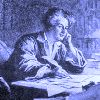 In part one of this series, I discussed the pros and cons of insisting on killer opening lines, how it serves the interests of agents and editors more than readers, yet how a strong first line can still lend an air of dignity and confidence to any story. In part two, I presented my favorite first lines based on engaging ideas.
In part one of this series, I discussed the pros and cons of insisting on killer opening lines, how it serves the interests of agents and editors more than readers, yet how a strong first line can still lend an air of dignity and confidence to any story. In part two, I presented my favorite first lines based on engaging ideas.
Today I want to dig into my second list of Best First Lines, six of them, dedicated to openers that present the reader with an engaging character.
You might think that the “engaging character” in question would always be the first-person narrator but, as we’ll see, that’s not always the case.
The Engaging Character
“If you really want to hear about it, the first thing you’ll probably want to know is where I was born, and what my lousy childhood was like, and how my parents were occupied and all before they had me, and all that David Copperfield kind of crap, but I don’t feel like going into it, if you want to know the truth.” – The Catcher in the Rye by J. D. Salinger.
Yes, this appears on nearly every Best First Lines list you can find, but take this extra little something from it: Salinger is simultaneously establishing the character of Holden Caulfield and signaling a break with the conventions of previous fiction.
÷∞÷
“He was an inch, perhaps two, under six feet, powerfully built, and he advanced straight at you with a slight stoop of the shoulders, head forward, and a fixed from-under stare which made you think of a charging bull.” – Lord Jim by Joseph Conrad.
This excellent first line does double duty in the “engaging character” department, describing the eponymous Lord Jim and introducing the voice of Charles Marlow, whom Conrad first channeled in the short story Youth and the novel Heart of Darkness
. After Lord Jim, Marlow also appears in Chance
. Using a first line to present the reader with two key characters? Genius.
÷∞÷
“Scarlett O’Hara was not beautiful, but men seldom realized it when caught by her charm as the Tarleton twins were.” – Gone with the Wind by Margaret Mitchell.
Did you realize that Scarlett O’Hara was not beautiful? No? Then you’ve been fooled by Hollywood casting and Vivien Leigh. I have discussed the ways I felt the film surpassed the novel, but a Southern belle who relies more on charm than looks is a far more intriguing character than the gorgeous Scarlett of the silver screen. Edge to Mitchell on this point.
÷∞÷
“A green hunting cap squeezed the top of the fleshy balloon of a head.” A Confederacy of Dunces by John Kennedy Toole.
The only thing I think I can add to this wonderful description is to point out that an inanimate object is the subject of this active voice sentence describing the lazy Ignatius Reilly. Revealing character through grammar might seem inaccessibly writer-geekerish, but Toole’s inaccessible genius eventually secured Confederacy a Pulitzer. Unfortunately, post mortem.
÷∞÷
“People do not give it credence that a fourteen-year-old girl could leave home and go off in the wintertime to avenge her father’s blood but it did not seem so strange then, although I will say it did not happen everyday.” – True Grit by Charles Portis.
I have reviewed True Grit in an earlier post, and a fuller examination of the character of Mattie Ross can be found there. All I will say here is that a writer who can slap down a full house like this — three solid story details and a double dose of character — has a bright future in the world of fiction.
÷∞÷
“Mrs Dalloway said she would buy the flowers herself.” – Mrs Dalloway by Virginia Woolf.
I almost didn’t include this one, because it uses the gimmick I ruled out in part one of this Best First Lines series: it dumps a riddle on the reader’s head to get him to read the next sentence simply to find out why Mrs. Dalloway was buying flowers herself. I relented because Woolf accomplishes an incredible amount with these nine words. She introduces the main character, sets up suspicion about that character by having her “say” she would buy flowers rather than simply doing it, and calls into question the behavior of other characters by implying that Dalloway might not be the usual purchaser of the flowers in question. By far the most efficiently powerful first line in this list.
